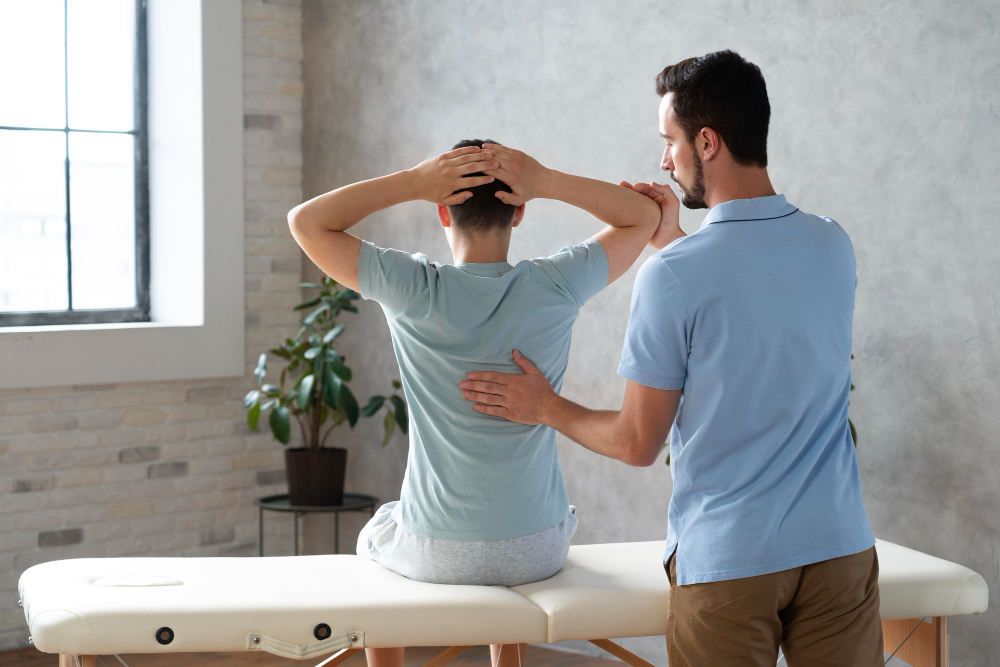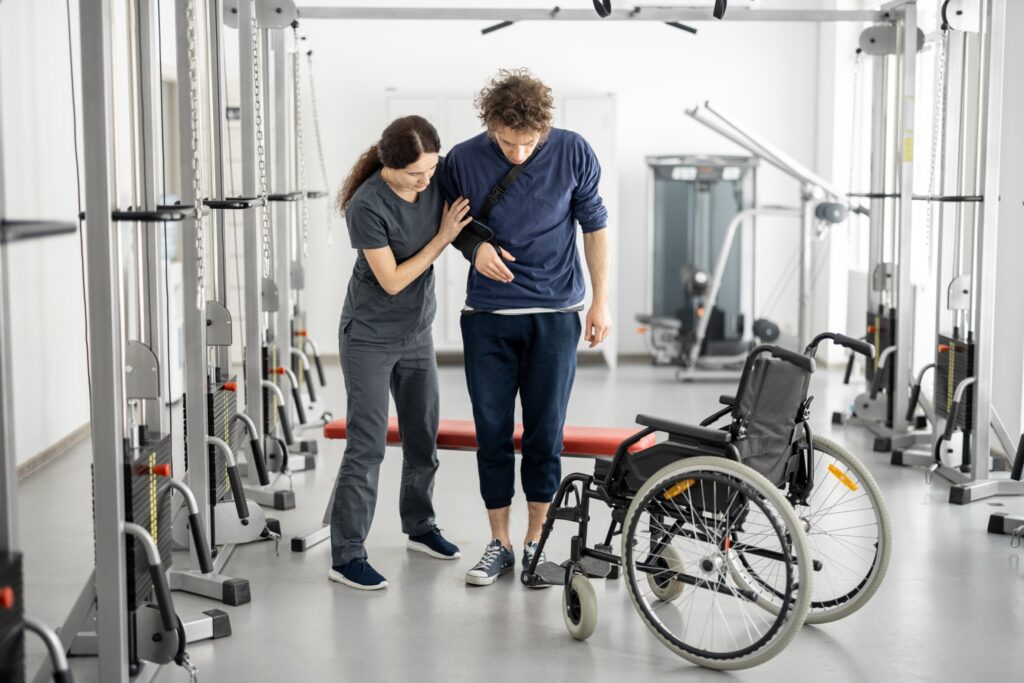Introduction
Good attitude is needed to maintain general health and prevent long-term musculoskeletal problems. Poor attitude can cause chronic pain, reduce mobility and even affect mental welfare. Many individuals in Hyderabad face the challenges related to attitude due to sedentary lifestyle and long -term screen exposure. This guide covers everything you need to know about Best Posture Correction in Hyderabad, from expert solutions and home exercises to advanced treatment options available in Hyderabad.
Understanding Posture – The Basics
What Defines a Good Posture ?
- A good posture aligns the spine properly, ensuring minimal strain on muscles and joints
- It involves keeping the head, shoulders, and hips in a balanced position to distribute body weight evenly
- Maintaining proper posture reduces stress on ligaments and prevents long-term spinal issues
- Good posture also enhances breathing, circulation, and overall body functionality
The Science Behind Proper Alignment of the Spine
- The spine has three natural curves—cervical, thoracic, and lumbar—which help absorb shocks and support movement
- Proper alignment ensures that these curves are maintained without excessive strain
- Misalignment can lead to chronic back pain, joint stiffness, and nerve compression
- A well-aligned spine improves mobility, stability, and posture longevity
How Your Lifestyle and Habits Affect Your Posture
- Daily habits play a crucial role in maintaining or damaging posture
- Prolonged sitting, improper lifting techniques, and sleeping in incorrect positions contribute to spinal misalignment
- A lack of physical activity weakens core muscles, making it harder to support proper posture
- Simple lifestyle changes, such as using ergonomic furniture and regular stretching, can significantly improve posture over time
Causes of Poor Posture
- Sedentary Lifestyles and Desk Jobs
- Prolonged sitting weakens core muscles, leading to postural imbalances
- Increases strain on the spine, causing stiffness and discomfort
- Regular movement breaks and ergonomic adjustments help counteract these effects
- Weak Muscles and Poor Core Strength
- A weak core fails to support the spine, leading to slouching
- Poor muscle strength results in spinal misalignment and postural issues
- Strength training and posture-focused exercises help improve core stability
- Impact of Prolonged Screen Time
- Excessive phone and computer use causes forward head posture and rounded shoulders
- Increased stress on the neck and spine leads to chronic pain
- Using an ergonomic screen setup and taking frequent breaks can prevent misalignment
- Incorrect Sleeping Positions
- Poor mattress support and improper sleeping positions misalign the spine
- Leads to chronic back pain, stiffness, and postural discomfort
- Sleeping on a supportive mattress and maintaining a neutral spine position is beneficial
- Stress and Anxiety
- High stress levels cause muscle stiffness and unconscious hunching
- Poor posture develops due to tension in the neck, shoulders, and back
- Yoga, deep breathing, and relaxation techniques help relieve stress and improve posture
Common Posture-Related Issues
- Forward Head Posture
- Caused by excessive phone and computer use, straining the neck and shoulders
- Leads to headaches, stiffness, and chronic neck pain
- Targeted therapies help realign the neck and shoulders effectively
- Rounded Shoulders
- Weak upper body muscles and prolonged desk work cause slouched shoulders
- Affects spinal alignment and reduces breathing capacity
- Strengthening back muscles and practicing correct posture techniques can help
- Lower Back Pain
- Poor sitting posture puts excessive pressure on the lumbar spine
- Leads to chronic pain, discomfort, and mobility issues
- Core exercises and lumbar support solutions maintain spinal alignment
- Scoliosis and Postural Misalignments
- Abnormal spinal curvatures cause back pain and mobility limitations
- Requires specialized treatment and corrective therapies
- Personalized rehabilitation programs help manage scoliosis-related concerns
- Hip and Knee Pain
- Poor posture causes uneven weight distribution, stressing lower body joints
- Leads to pain in the hips and knees due to improper alignment
- Strengthening hip and leg muscles and correcting posture alleviates discomfort
Best Posture Correction Clinics in Hyderabad
- Hyderabad is home to several renowned posture correction centers that offer specialized care and treatments
- Best Posture Correction in Hyderabad includes services from Movement School Physiotherapy, which provides expert physiotherapy and rehabilitation programs tailored to posture correction
- Top chiropractic clinics in the city specialize in spinal adjustments to improve alignment and relieve discomfort
- Ergonomic consultation services help office workers set up posture-friendly workstations to prevent musculoskeletal problems
- These clinics use advanced diagnostic tools to assess posture and create customized treatment plans for long-term relief
Advanced Techniques for Posture Correction
- Postural Rehabilitation Therapy
- Corrects muscular imbalances and restores proper body alignment
- Strengthens weak muscles through targeted exercises and therapy sessions
- Ideal for individuals with postural misalignment from prolonged sitting or poor habits
- Chiropractic Adjustments
- Realigns the spine and reduces nerve compression
- Helps relieve pain, improve mobility, and enhance spinal health
- Prevents future postural issues with regular chiropractic care
- Myofascial Release Techniques
- Targets muscle tension and adhesions in the fascia
- Improves flexibility and releases tight muscles
- Beneficial for chronic stiffness and restricted movement
- Dry Needling Therapy
- Involves inserting thin needles into muscle knots and trigger points
- Reduces chronic pain and restores normal movement patterns
- Enhances muscular function and relieves tension from postural discomfort
- Electrotherapy for Pain Relief
- Uses electrical impulses to stimulate muscles and reduce inflammation
- Enhances muscle activation and promotes healing
- Supports posture correction treatments in physiotherapy clinics
Exercises to Improve Posture at Home
Regular stretching at your desk helps counteract the negative effects of prolonged sitting. Neck stretches, shoulder rolls, and seated spinal twists improve flexibility and circulation. These simple movements reduce stiffness and prevent posture-related discomfort.
Core Strengthening Workouts
A strong core provides essential support for maintaining good posture throughout the day. Exercises like planks, bridges, and dead bugs strengthen abdominal and lower back muscles. Improved core strength reduces spinal strain and enhances overall stability.
Yoga Poses for Better Posture
Yoga promotes spinal alignment, flexibility, and muscle balance, essential for good posture. Poses like cobra, cat-cow, and downward dog stretch and strengthen the back and neck. Practicing yoga regularly improves mobility and prevents stiffness.
Resistance Band Exercises for Postural Support
Using resistance bands helps build upper back, shoulder, and postural muscle strength. Rows, reverse flys, and band pull-aparts improve shoulder stability and alignment. Strengthening these muscles prevents slouching and supports an upright posture.
Daily Mobility Drills for Spinal Health
Gentle mobility drills keep the spine flexible and reduce stiffness caused by prolonged inactivity. Neck rolls, hip circles, and spinal twists enhance joint movement and prevent postural imbalances. Performing these exercises daily helps maintain long-term postural health.
Posture Correction for Different Age Groups
Developing good posture early helps prevent long-term spinal issues and discomfort. Using well-fitted backpacks, maintaining an active lifestyle, and avoiding prolonged screen time can support healthy alignment. Encouraging proper sitting and standing habits ensures strong postural foundations for adulthood.
Long hours at desks and improper sitting postures can lead to chronic pain and stiffness. Regular movement, stretching exercises, and ergonomic office setups help reduce strain on the spine. Strengthening core muscles and maintaining an active lifestyle are key to long-term posture health.
Aging naturally leads to reduced bone density, joint stiffness, and weaker muscles, increasing the risk of poor posture. Gentle exercises, such as yoga or walking, help improve flexibility and stability. Supportive footwear and proper seating arrangements can significantly enhance comfort and mobility.
Frequently Asked Questions (FAQs)
- How long does it take to correct poor posture ?
- The timeline depends on the severity of the issue
- Consistent exercises and therapy can show improvements in a few weeks to months
- Professional guidance enhances results and ensures proper alignment
- Can posture correction help with chronic back pain ?
- Yes, maintaining proper posture reduces strain on the spine
- It helps relieve chronic back pain and prevents future discomfort
- Strengthening core muscles further supports spinal health
- Is chiropractic care safe for posture correction ?
- Chiropractic adjustments are generally safe when performed by trained professionals
- They help restore proper spinal alignment and mobility
- Regular sessions can improve posture and reduce pain
- What are the best sleeping positions for good posture ?
- Sleeping on your back with proper pillow support maintains spinal alignment
- Side sleeping with a pillow between the knees reduces pressure on the lower back
- Avoid stomach sleeping, as it strains the neck and spine
- Do posture corrector braces really work ?
- Posture braces provide temporary support but are not a long-term solution
- They should be used alongside exercises to strengthen posture muscles
- Over-reliance on braces can weaken muscles over time
For expert guidance, visit Movement School Physiotherapy today and experience the Best Posture Correction in Hyderabad!
📍 Contact Details: 📞 Phone: 9000882858, 9000894989
📩 Email: writeus@movementschool.in | movementschoolphysioclinics@gmail.com
🌐 Website: Movement School Physiotherapy


